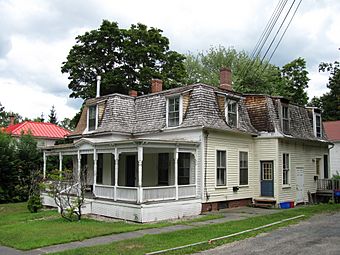Prospect-Gaylord Historic District facts for kids
Quick facts for kids |
|
|
Prospect-Gaylord Historic District
|
|

A house on North Prospect Street
|
|
| Location | Amherst, Massachusetts |
|---|---|
| Area | 16.8 acres (6.8 ha) |
| Architect | Howland, Warren S. |
| Architectural style | Colonial Revival, Greek Revival, Italianate |
| NRHP reference No. | 93000007 |
| Added to NRHP | February 4, 1993 |
The Prospect—Gaylord Historic District is a special area in Amherst, Massachusetts. It's called a historic district because it has many old buildings that are important to history. Most of the houses here were built in the late 1800s.
This district is just outside the main part of Amherst. It includes most of the houses on Prospect Street, which runs next to Pleasant Street. It also covers properties on Gaylord and Amity Streets. These streets go west from Prospect Street.
Discovering the Historic District
The houses in the Prospect—Gaylord Historic District show different styles from the late Victorian era. Many are in the Queen Anne style. This style often has towers, turrets, and decorative details. Some houses, like the one at 24 Gaylord Street, are simpler. They are built in a more everyday style.
Hope Community Church
A very important building in this district is the Hope Community Church. This church was built in 1912. It has a long history with the African American community in Amherst. Their congregation started way back in 1869.
W.E.B. Du Bois's Role
Money for building the church was raised with help from W.E.B. Du Bois. He was a famous writer, historian, and civil rights leader. His efforts helped make the church a reality. The Prospect—Gaylord Historic District was officially added to the National Register of Historic Places in 1993. This means it's recognized as a special place worth protecting.
How Amherst Grew Over Time
Amherst was first settled in the 1600s. For a long time, it was mostly a farming area. It had farms spread out across the land. In the early 1800s, the town center started to become more important. More businesses opened there.
The Rise of Amherst College
The town center became even more important when Amherst College was founded. This college opened in 1825. It brought more people and activity to the area.
Developing Prospect and Gaylord Streets
Prospect Street was created in 1824. It connected Amity Street, which was very old (from 1703), to Northampton Street. Northampton Street was the main road to the Connecticut River. At first, this area had small Greek Revival style houses. They were built on small pieces of land.
North Prospect Street, which is north of Amity Street, was developed later. It had bigger lots and houses with typical Victorian designs. Gaylord Street was first made as a private road in the early 1880s. Soon after, it was lined with beautiful Queen Anne style houses and other later styles.



